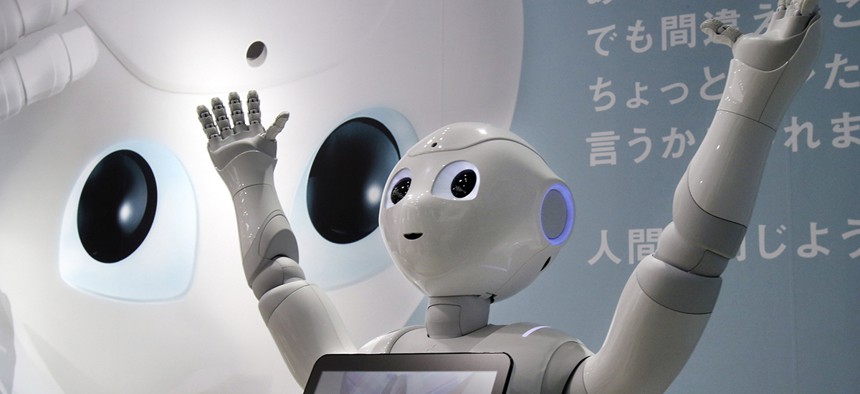What Skills Will Human Workers Need When Robots Take Over?

Humanoid Robot "Pepper" is displayed at SoftBank Mobile shop in Tokyo. Koji Sasahara/AP
A new algorithm would let the machines decide
A few years ago, Michael Osborne and a colleague at Oxford University caused a stir when they published research suggesting 47 percent of jobs in the U.S. are at risk of being replaced with robot labor. Subsequent studies suggest closer to 10 percent of jobs in developed countries could be automated, which is only marginally less worrying for workers.
What isn’t in doubt is that advances in algorithms and robotics will transform the workplace, with both rote manual labor and higher-level cognitive tasks soon to be performed by machines. Robotics companies, keen to avoid the insinuation their products take jobs from humans, talk a lot these days about “co-bots” (collaborative robots). Humans and robots will increasingly collaborate, they say, with humans freed to do more productive, fulfilling tasks thanks to machines taking on the grunt work.
Osborne’s latest project aims to predict what skills—independent of specific jobs—will be in highest demand among employers in 2030.
“A child starting education this year will enter a jobs market very different from what we see now,” says Mark Griffiths, research head at Pearson, the publishing and education company partnering in the research.
To determine what skills workers will need in an increasingly automated workplace, researchers–appropriately enough–plan to ask the machines.
Osborne, Pearson, and innovation nonprofit Nesta will run a series of workshops later this year with businesses, academics, futurists and others with opinions about the future of work. These meetings in the U.S. and U.K. will provide the raw material for a machine-learning algorithm, which will filter and refine the humans’ predictions. A report of the findings will be released early next year.
The algorithm will cross-reference what jobs humans think will be in high demand in 2030 with a large database of job-specific skills compiled by the U.S. Labor Department. For example, accountants, according to the database, need to master more than 30 skills and abilities, including things like “critical thinking,” “systems analysis” and “inductive reasoning.”
Based on initial feedback from the workshops, the algorithm will identify “subtle interdependencies” in the skills required for the jobs that people think will be prevalent in the future, Osborne says. The computer will then propose other occupations for the experts to rate and debate during later sessions.
“The algorithm is always going to be testing the labels that human experts provide,” he adds.
Jobs in the future will require “mixes and depths of skills that are currently rare,” according to Osborne. Educators and policymakers need to prepare young people now so they’re prepared for this brave new world by the time they graduate, and not be beholden to job profiles and expectations that exist today. That’s why it makes sense to ask machines how we can be of best use, says Hasan Bakshi of Nesta. “It pares down the biases if left purely to humans.”






